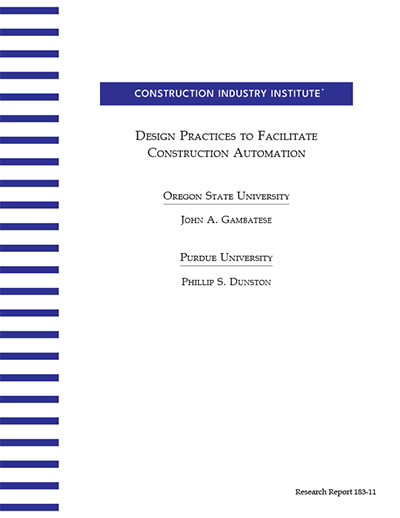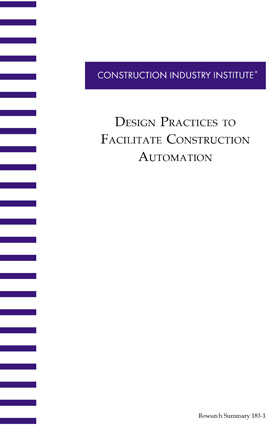
Design Practices to Facilitate Construction Automation
Automation in the construction industry involves the use of mechanical and electronic means to achieve automatic operation or control to reduce exposure, time, or effort while maintaining or improving quality. Contractors use automation to reduce costs and schedule, improve production, quality, and safety, and gain related project benefits. Automation in construction, however, has not kept pace with other industries and remains a predominantly labor-intensive activity.
Many factors limit the use of automation in construction. Cost, availability, and applicability of automated technologies, along with the knowledge and training required to operate the technologies, are obstacles to implementation. The design of permanent features and the means used to communicate the design may either inhibit or prohibit the use of automated technologies during construction.
CII created the Design Practices to Facilitate Construction Automation Project Team (PT-183) to investigate this issue. The resulting research has identified design practices that facilitate the implementation of automated technologies and exposed barriers to and limitations of addressing automation in design. Recommended design practices to facilitate the use of construction automation include:
- Conduct constructability reviews during the design phase that incorporate consideration of construction automation.
- Standardize design features and elements.
- Provide adequate clearance for automated technologies to operate.
- Prioritize design objectives and compare design alternatives.
- Use electronic documents and make the documents available to the contractor.
- Consider the capabilities and limitations of the automated technologies.
Numerous factors hinder the consideration of automation, including the structure of the industry, a lack of applicable knowledge by design professionals, and the limitations of the technologies themselves. To implement the findings, the industry and project participants need to:
- Provide for efficient, timely exchange of project information between constructors and designers.
- Conduct constructability reviews as a means to facilitate the application of construction automation knowledge in the design phase.
- Modify traditional contracting arrangements to allow for expanded interaction between designers and constructors.
- Recognize that designer compensation may need to be modified to provide incentive to consider construction automation in design.
- Expand education and training of designers regarding construction automation.
This research report describes the research effort undertaken for the study. The findings of the study are also available on the Emerging Construction Technologies website (www.new-technologies.org/ECT/Index.html).



